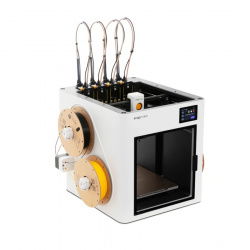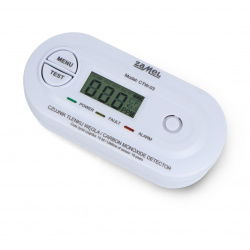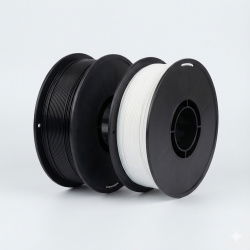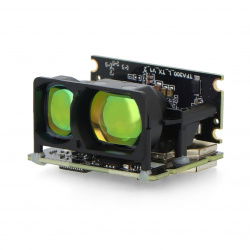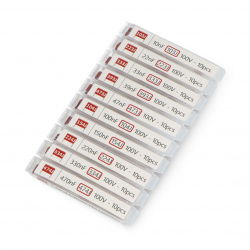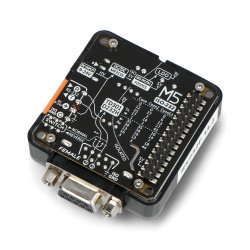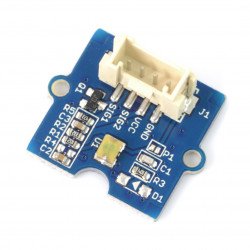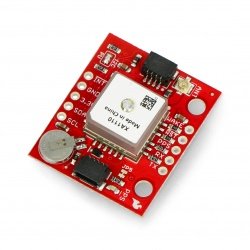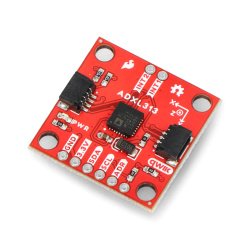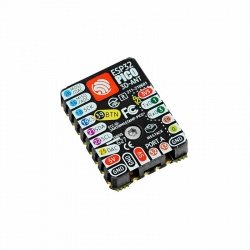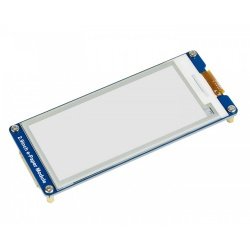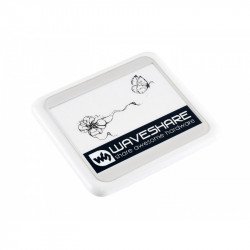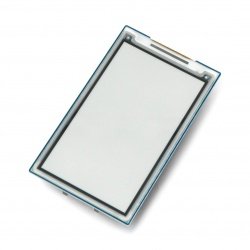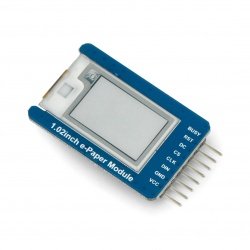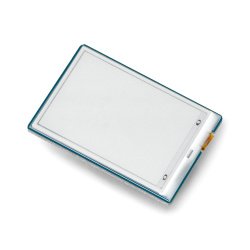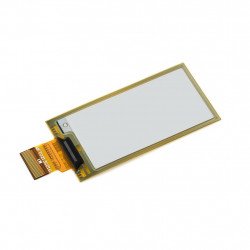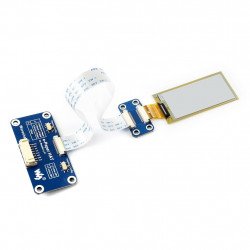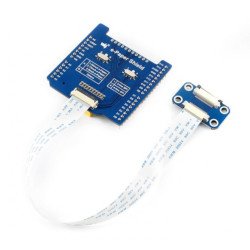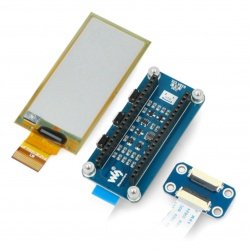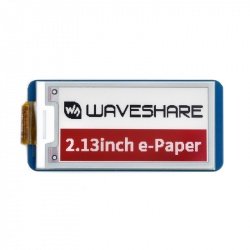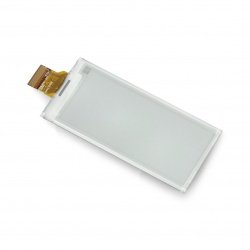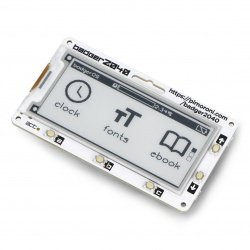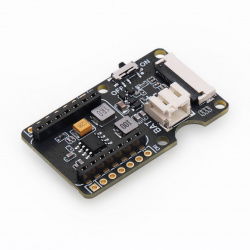For a long time, electronic paper technology was underestimated. 40 years have passed since it was invented for commercial use. Today, e-paper displays are very versatile, they are appreciated for their energy efficiency and very good image quality. They reflect light, just like paper, which distinguishes them from conventional flat-screen displays. This makes the emitted image more readable and we can see it better even in more difficult conditions, in sunny weather. Moreover, e-paper displays consume little energy, are energy efficient, which in turn results in low operating costs. The image quality, in turn, is also affected by high contrast. E-paper is a technology that provides image display by means of microscopic containers, which are filled with dark and white capsules. In the offer of Botland store you will find a wide range of displays created on the basis of this technology. They are a very good alternative to conventional displays.
E-paper displays
- Reduced price
- SPECIAL OFFERS
M5PaperS3 - developer module with 4,7'' 960x540px e-Ink display - ESP32-S3 - M5Stack C139
M5PaperS3 is a development module based on ESP32-S3 equipped with a 4.7'' e-Ink touch display with a resolution of 960 x 540 px , supporting up to 16 levels of grayscale...E-paper E-Ink 2.9'' 296x128px - SPI display module - Waveshare 12956
Module with 2.9" e-paper display with a resolution of 296 x 128 px. Communicates via the SPI interface, e.g. with Arduino or Raspberry Pi.E-Paper 4,2'' 400x300px - display powered by NFC - Waveshare 17341
The e-paper display by Waveshare, allows you to easily display the image or graphic you need, by using a dedicated smartphone app and NFC transmission. An additional...E-paper of 2.13" 250x122px display (no module) for overlays for the Raspberry Pi - Waveshare 12672
The display of type of e-paper with a diagonal of 2.13 " and a resolution of 250 x 122 px. It is designed to use with shield for Raspberry Pi. It communicates via the SPI...E-paper E-Ink - module with SPI display - 128x80px 1.02'' - dual-color - Waveshare 17575
E-paper E-Ink display module made by Waveshare. It has a built-in controller that uses SPI bus to communicate with external controllers like Arduino or Raspberry Pi. The...E-paper E-Ink - I2C display module - 91 segments 1,9'' - Waveshare 22689
E-paper segment display with a diagonal of 1.9 ", consisting of 91 segments . The passive reflective screen is able to display a black and white image, the viewing angle is...2.13'' e-Paper E-ink flexible display (D) 212x104px - Waveshare 14986
Flexible display e-paper 2.13" with a resolution of 212 x 104 pixels. Communicates via SPI interface. Supports partial updates. Compared to conventional e-Paper displays ,...E-paper E-Ink flexible display (D) 2,13'' 212x104px HAT for Raspberry Pi - Waveshare 15084
Shield for Raspberry Pi with a flexible display e-paper of 2.13 " with a resolution of 212 x 104 pixels. It is connected directly to GPIO pins. It communicates via SPI...- Sale
E-Paper Raw Panel Driver Shield - Shield for e-Paper Display for Arduino - SPI - Waveshare 15082
Universal shield for connection of displays e-Paper for modules of Arduino or Nucleo. For communication, it uses SPI interface. It works with a voltage of 3.3 V and 5 V.- Reduced price
- SPECIAL OFFERS
Badger 2040 - board with RP2040 and e-paper 2,9'' 296x128px display + accessories - Pimoroni PIM610
The Badger 2040 board was created by Pimoroni in honor of the 10th anniversary of the Raspberry Pi. The module is based on the RP2040 Dual-Core ARM Cortex M0 + microcontroller...2.13'' E-Paper E-Ink display 212x104px - SPI - 3 colors - for Raspberry Pi Pico - Waveshare 19588
A 2.13'' e-paper display designed for the Raspberry Pi Pico. Its resolution is 212 x 104 px . The screen presents images and texts in three colors: red , black and...Display e-paper - 1.64'' 168x168px - 4 colors - SPI - Waveshare 22755
Waveshare display made on the basis of e-paper technology, which makes this type of display suitable for use in e-book readers and electronic magazines. The diagonal of the...E-paper E-Ink (B) 1.54'' 200x200px - three-color display (without module) - Waveshare 13275
Module with 1.54" e-paper display with an E-Ink technology with a resolution of 200 x 200 pixels. Works with a voltage of 3.3 V. Designed for use with the main module....E-Paper E-Ink Display 2,9'' 296x128px - SPI - 3 colors - for Raspberry Pi Pico - Waveshare 19607
296 x 128 px resolution e-paper display dedicated to the popular Raspberry Pi Pico. Its diagonal is 2.9'' . It presents content in three colors: red , black and white ....E-paper E-Ink 2.9'' 296x128px - display (without module) - Waveshare 12563
E-paper type display with a diagonal of 2.9" and a resolution of 296 x 128 px. Designed for use with the main module. Communicates via the SPI interface and supports partial...E-paper E-Ink 1.54'' 200x200px - display (without module) - Waveshare 12561
E-paper type display with a diagonal of 1.54" and a resolution of 200 x 200 px. Designed for use with the main module. Communicates via the SPI interface and supports partial...Badger 2040 - board with RP2040 and e-paper 2,9'' 296x128px display - Pimoroni PIM607
Badger 2040 was created by the Pimoroni company in honor of the 10th anniversary of the Raspberry Pi. The board is based on a dual-core RP2040 ARM Cortex M0 + microcontroller...ePaper Driver Board for Seeed Xiao V2 - Seeedstudio 114993558
The ePaper Driver Board is a universal extension for ePaper displays, optimized for projects with Seeedstudio Xiao microcontrollers. The device offers a wide range of...E-paper touch display - 2,13'' 250x122px - black and white - hat for Raspberry Pi - Waveshare 19493
HAT overlay for Raspberry Pi in the form of a touch capacitive e-paper display . This type of display uses electrophoretic microcapsule technology to present images. It...- Reduced price
- SPECIAL OFFERS
See also
Electronic paper - energy-saving and practical displays
Electronic paper uses plastic substrates for the display. This makes e-ink screens flexible - this significantly increases the scope of their use. They can be used as electronic price tags in stores, information boards at bus stations, electronic billboards, and e-book readers. Currently, most e-ink displays are black and white (with the option of gray display).
Low power consumption thanks to the unique operating principle
Many electronic e-ink displays maintain static text or images on the display without access to a power source. They are sometimes called electrophoretic displays. They create images by rearranging charged pigment particles with an applied electric field. Therefore, power for the e-ink screen is only needed when the displayed image changes. Due to their low energy consumption, this type of displays are often used in battery-powered portable equipment.
Clear and ergonomic image
The electronic paper display perfectly emulates a sheet of paper. Thanks to high contrast and the use of only reflected light, these types of screens are not tiring for the eyes. E-ink displays are available in many formats and sizes. Thanks to the relatively high resolution and dynamic range, these displays can present not only text, but also simplified illustrations, icons and graphics. Additionally, the ergonomics of this type of displays is improved by the possibility of mounting flexible screens on surfaces of any shape - thanks to this, the shape of the screen can be adjusted to the geometry of the device.
E-paper displays - FAQ
E-paper, i.e. e-paper display, is a special type of display that imitates an ordinary sheet of paper in its appearance. Unlike standard displays , e-paper does not emit blue light. The principle of operation of displays imitating ordinary paper is based on light reflection. In practice, this means that it is fully readable from various angles. Other advantages of e-paper displays are low electricity demand and high contrast.
When choosing an e-paper display, you should pay attention to several important factors. The first is the communication interface enabling the display to be connected to external devices. The most popular communication interfaces are GPIO, SPI, SPI + I2C, NFC and USB . Another issue is the screen size. The larger the screen diagonal, the more readable the text and graphics displayed. In turn, the quality of the displayed content is influenced by the screen resolution. The higher it is, the more detailed the content is presented.






























































































































































































































































































































